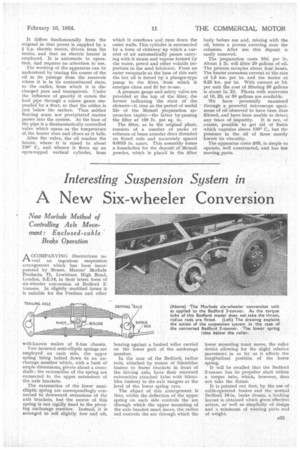Waste-oil
Page 32

Page 33

If you've noticed an error in this article please click here to report it so we can fix it.
An Improved
Reclaiming Apparatus
OR economical maintenance of in ternal-combustion transport engines it is widely acknowledged that. the lubricating oil should be • frequently renewed, and that only oil of first quality should be employed. Together these two conditions represent a big item of expense. One would not hesitate frequently to drain off, as waste, cheap oil, or to buy good-quality lubricant if it could be used for long periods, but to cast away expensive oil, after only a short period of use, appears, at first sight, gross extravagance. The B22 obvious solution to the problem is to purify the used oil and to employ it again and again.
In our issue dated June 9, 1933, we described an inexpensive oil-reclamation apparatus, made by the Metafiltration Co., Ltd., Belgrave Works, Hounslow, Middlesex, in which a filter element employing the concern's well-known Metasil preparation was incorporated, the oil being heated and pumped through the filter by a small petrol engine. The accompanying illustration shows the Metafilter in its latest form. It differs fundamentally from the original in that power is supplied by a h-p. electric motor, driven from the mains, aud that an electric heater is employed. It is automatic in operation, and requires no attention in use.
The working of the apparatus can he understood by tracing the course of the oil in its passage from the reservoir where it is in its contaminated state, to the outlet, from which it is discharged pure and transparent. Under the influence of gravity it enters the feed pipe through a coarse gauze suspended by a float, so that the orifice is just below the surface. Thus neither floating scum nor precipitated matter passes into the system. At the base of the pipe is a thermostatically controlled valve 'which opens as the temperature of the heater rises and closes as it falls.
After the valve, the oil reaches the beater, where it is raised to about 1300 C., and whence it flows tip an open-topped vertical cylinder, from
which it overflows and runs down the outer walls. This cylinder is surrounded by a form of chimney up which a current of air automatically passes carrying with it steam and vapour formed by the water, petrol and other volatile impurities in the used lubricant. From an outer receptacle at the base of this unit the hot oil is forced by a plunger-type pump to the filter, from which it emerges clean and fit for re-use.
A pressure gauge and safety valve are provided at the top of the filter, the former indicating the state of the element—it rises as the periodof useful life of the Metasil preparation approaches expiry—the latter by-passing the filter at 100 lb. per sq. in.
The filter, as in the original plant, consists of a number of packs or columns of brass annular discs threaded on fluted rods and accurately spaced 0.0015 in. apart. This assembly forms a foundation for the deposit of Metasil powder, which is placed in the filter body before use and, mixing with the oil, forms a porous coveting over the columns. After use this deposit is easily removed.
The preparation costs 10d. per lb. About lb. will filter 20 gallons of oil. The process occupies about four hours. The heater consumes. current at the rate of 1.5 kw. per hr. and the motor at 0.25 kw. per hr. With current at id. per unit the cost of filtering 20 gallons is about 1s. 2d. Plants with reservoirs of 10, 20, or 50 gallons are available.
We have personally examined through a powerful microscope specimens of oil observed to have been thus filtered, and have been unable, to detect
any trace of impurity. It is not, of course, possible to get rid of fluids which vaporize above 1.30° C„ but the presence in the oil of these merely lowers its viscosity.
The apparatus costs £65, is simple to operate; well constructed, and has few moving parts.




















































































